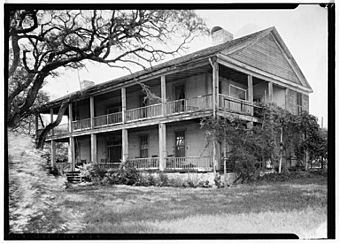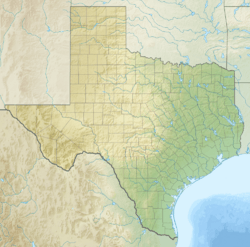Seward Plantation facts for kids
Quick facts for kids |
|
|
Seward Plantation
|
|

John H. Seward House
|
|
| Location | 10005 FM 390 E, Independence, Texas |
|---|---|
| Area | approx. 60 acres (24 ha) |
| Built | 1855 |
| Built by | John H. Seward |
| Architectural style | Greek Revival |
| NRHP reference No. | 12001250 |
| Added to NRHP | January 29, 2013 |
The Seward Plantation is a very old property in Independence, Texas. It was built in 1855. This historic site was once a large farm called a plantation. Later, it became a ranch. The Seward Plantation is important because it is listed on the National Register of Historic Places. It was added to this list on January 29, 2013. This means it is a special place that helps us understand history.
Contents
Where is the Seward Plantation?
The Seward Plantation is about 1 mile (1.6 km) east of Independence. It is also close to Brenham. Both towns are in Washington County, Texas. The property is located off Farm to Market Road 390. This road was once known as La Bahía Road.
The Old La Bahía Road
La Bahía Road has a long history. It started as a trail used by Native American tribes. Later, Spanish explorers used it in the 1600s. You can still see parts of this old road on the Seward Plantation today.
A Look Back: History of the Plantation
The story of the Seward Plantation began a long time ago.
The Seward Family Arrives
In the early 1830s, Samuel Seward (1794–1870) moved to Texas. He came from Illinois with Stephen F. Austin. Austin was a very important person in Texas history. Samuel Seward bought a lot of land, about 1,700 acres (688 hectares). He later bought 300 more acres (121 hectares).
Building the Main House
In the 1850s, Texas had become a state. Samuel's son, John Hoblett Seward (1822–1892), took over the land. John married Laura Jane Roberts (1838–1920). The main house on the plantation was built in 1855.
Moving the House
When it was first built, the house had only one story. It was about a quarter-mile away from Samuel Seward's house. But the first spot was not good. It was hard to reach when it rained. It was also unhealthy when it was cold. So, just one year after it was finished, the house was moved! Workers rolled it on big cottonwood logs for three-quarters of a mile. This brought it to its current location.
How the House Was Built
The house was made mostly from cedar trees. These trees grew right near the original building site. The house sits on a strong stone base. After it was moved, the Seward family added a second story. They also made other changes over the years. Once it was bigger, the plantation home became the largest house in Washington County.
Life on the Plantation
The property had many other buildings. There were barns and log cabins. There was also a smokehouse and a corn crib. A blacksmith's shop was on the property too. Many of these old buildings are still standing today.
From Cotton to Cattle
Before the American Civil War (1861–1865), the plantation grew cotton. Cotton was a very important crop in the Southern United States. After the war, the property changed. It became a cattle ranch instead of a cotton plantation.
The Plantation Today
The Seward Plantation house has survived many years. It even made it through a very big storm in 1900. The Seward family owned the plantation until 2017. Then, a new family from Houston bought it. They are working to fix up the property. The house is now a private home.
See also



